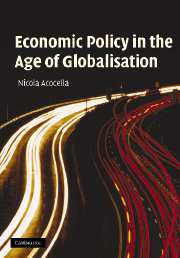Book contents
- Frontmatter
- Contents
- List of boxes
- List of tables
- List of symbols, abbreviations and acronyms
- Preface
- 1 Introduction
- Part I The market, efficiency and equity
- Part II Normative and positive theory of economic policy
- Part III Microeconomic policies
- Part IV Macroeconomic policies
- Part V Public institutions in an international setting
- Part VI Globalisation and the quest for a new institutional setting
- 19 The internationalisation of private institutions: the globalisation of markets and production
- 20 The challenges of globalisation for public policies
- Bibliography
- Author index
- Subject index
19 - The internationalisation of private institutions: the globalisation of markets and production
Published online by Cambridge University Press: 14 May 2010
- Frontmatter
- Contents
- List of boxes
- List of tables
- List of symbols, abbreviations and acronyms
- Preface
- 1 Introduction
- Part I The market, efficiency and equity
- Part II Normative and positive theory of economic policy
- Part III Microeconomic policies
- Part IV Macroeconomic policies
- Part V Public institutions in an international setting
- Part VI Globalisation and the quest for a new institutional setting
- 19 The internationalisation of private institutions: the globalisation of markets and production
- 20 The challenges of globalisation for public policies
- Bibliography
- Author index
- Subject index
Summary
Forms of globalisation
Globalisation has been variously defined (for example, see Oman, 1996). Here we define it briefly as the expansion on a global scale of the interrelations among national economic and social systems through private economic institutions. Such expansion is associated with the increase in international movements of goods, ‘financial’ capital and labour (shallow integration, in the terminology used by UNCTAD, 1994) and with an increase in international production, mainly by multinational corporations (deep integration). Globalisation is therefore a different phenomenon from (increased) competition in markets for goods and factors of production, although such an outcome is highly likely in certain stages of the globalisation process.
In order to grasp the scope and shape of globalisation, we first examine international trade in goods.
Overall, international trade expanded at a faster pace than GDP throughout the post-war period. The result was an increase in the degree of international openness of economies (defined as the ratio of exports to GDP), as shown in table 19.1. Among the factors of production, international capital movements have expanded rapidly, especially bank capital (table 19.2). International transactions in debt instruments and equities have also grown much more than GDP (table 19.3).
Total international migration flows have also increased since the Second World War: in 1990 about 120 million people were living outside their country of birth, compared with about 75 million in 1965. However, the ratio of such flows to population is broadly unchanged (World Bank, 1995, p. 52).
- Type
- Chapter
- Information
- Economic Policy in the Age of Globalisation , pp. 421 - 436Publisher: Cambridge University PressPrint publication year: 2005



